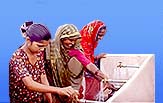 This Operation and Maintenance (O&M) manual for rural water supplies by the Department of Drinking Water And Sanitation and Water and Sanitation Program of the World Bank complements their Gram Panchayat Handbook released in 2010 . It takes into account the current aspirations and challenges facing the sector, and builds on the framework already set out in the National Rajiv Gandhi Drinking Water Programme (NRDWP) and Strategic Plan 2011-2022.
This Operation and Maintenance (O&M) manual for rural water supplies by the Department of Drinking Water And Sanitation and Water and Sanitation Program of the World Bank complements their Gram Panchayat Handbook released in 2010 . It takes into account the current aspirations and challenges facing the sector, and builds on the framework already set out in the National Rajiv Gandhi Drinking Water Programme (NRDWP) and Strategic Plan 2011-2022.
Much progress has been made in providing water supply facilities in rural India and by 2009 it has reached almost universal coverage for more than 850 million people in 1.6 million habitations. Given the scale of the challenge, this is a remarkable achievement. However, services have been slipping. About one half of habitations face challenges associated with source sustainability, water quality or operation and maintenance. These communities require interim strategies on the road towards piped water supply.
In this manual, the different types of rural water supply schemes are described in terms of basic details, operation & maintenance activities and resources. Most of the information has been extracted from the resource training package Management of Operation and Maintenance in Rural Drinking Water Supply and Sanitation (IRC, WHO and WSSCC, 1993). Simple one or two page tables (templates) have been prepared to help villages achieve improved and sustainable service delivery (O&M) -
- A technical/financial survey (including the sanitary survey).
- A water safety plan template to identify the main risks of contamination and common operational control measures and remedial actions.
- An operating plan template, which sets out the basic tasks of the operator, as well as how to calculate maintenance & staff costs, water revenues and the gap between costs & revenues.
- A service improvement plan template, which identifies typical problems that rural schemes encounter and provides guidance on prioritizing operational and infrastructure remedies (further technical support is needed to design and cost the remedies).
- Basic performance indicators which can be used by the Gram Panchayat, Block Resource Centre and District Water and Sanitation Mission to monitor implementation and performance.
These simple templates allow villages to assess the condition of their assets, the true costs of operations, and their current performance, and to identify operational and infrastructure remedies and how they propose to finance these.
The templates can also be used to guide development of training modules for local operators, field facilitators, Gram Panchayats, and Block Resource Centre and District Water and Sanitation Mission staff.